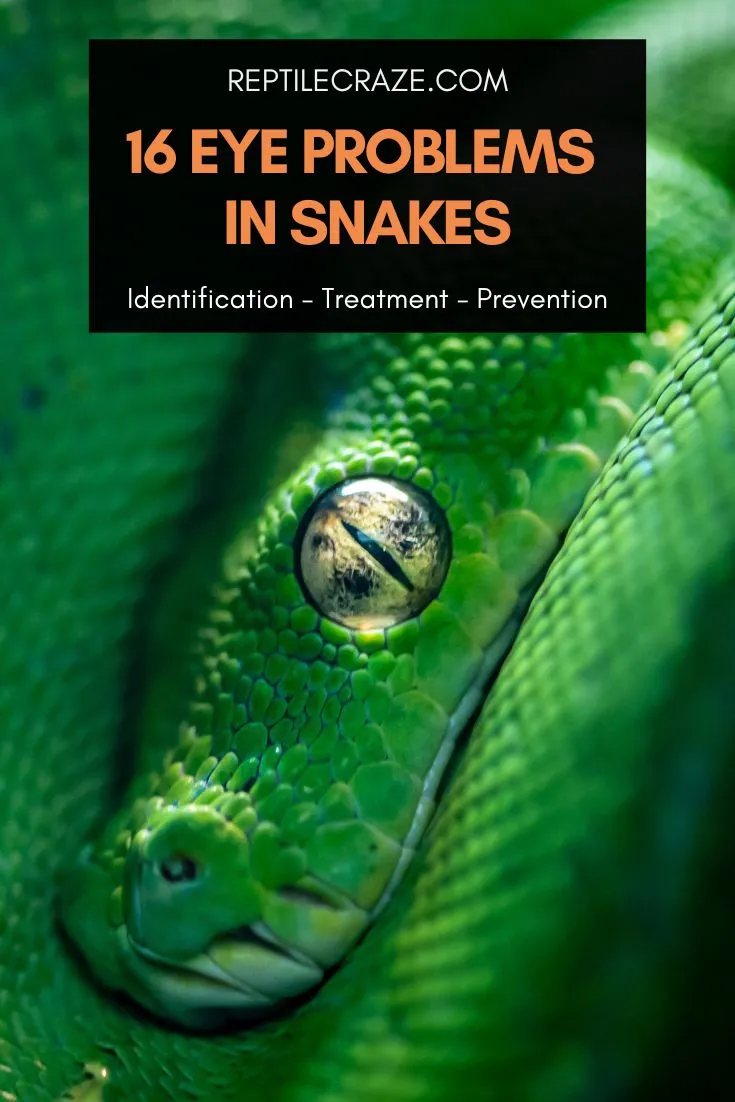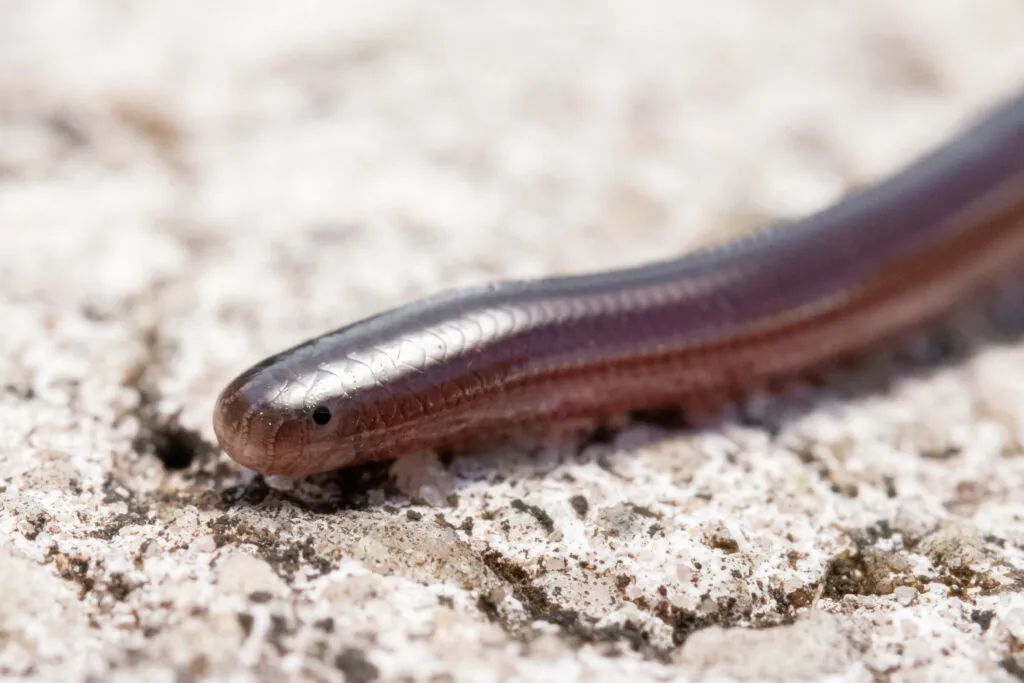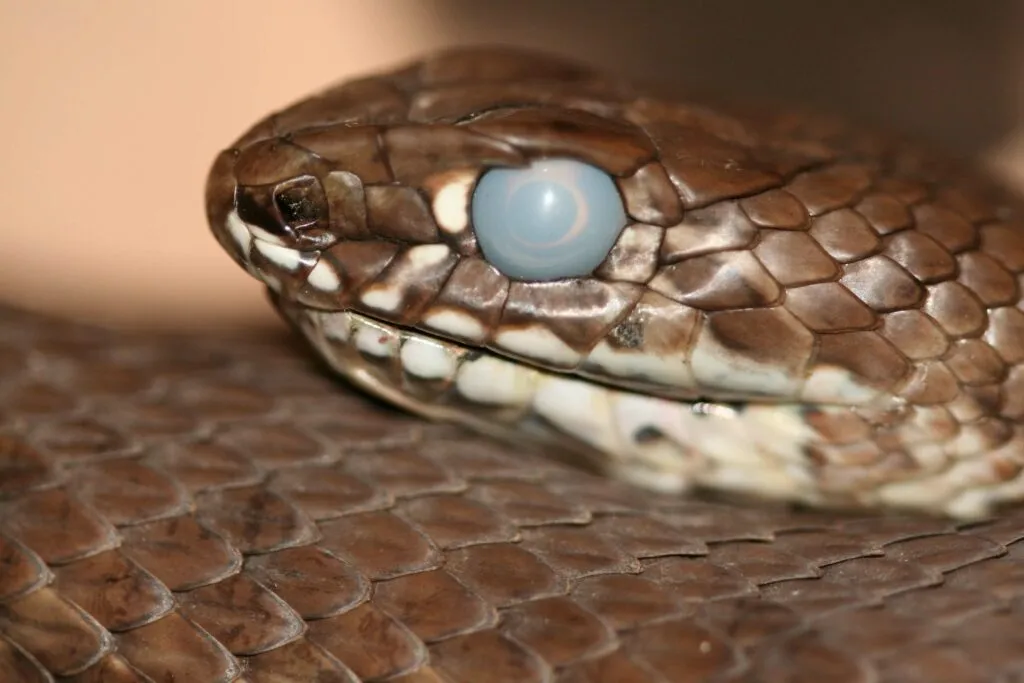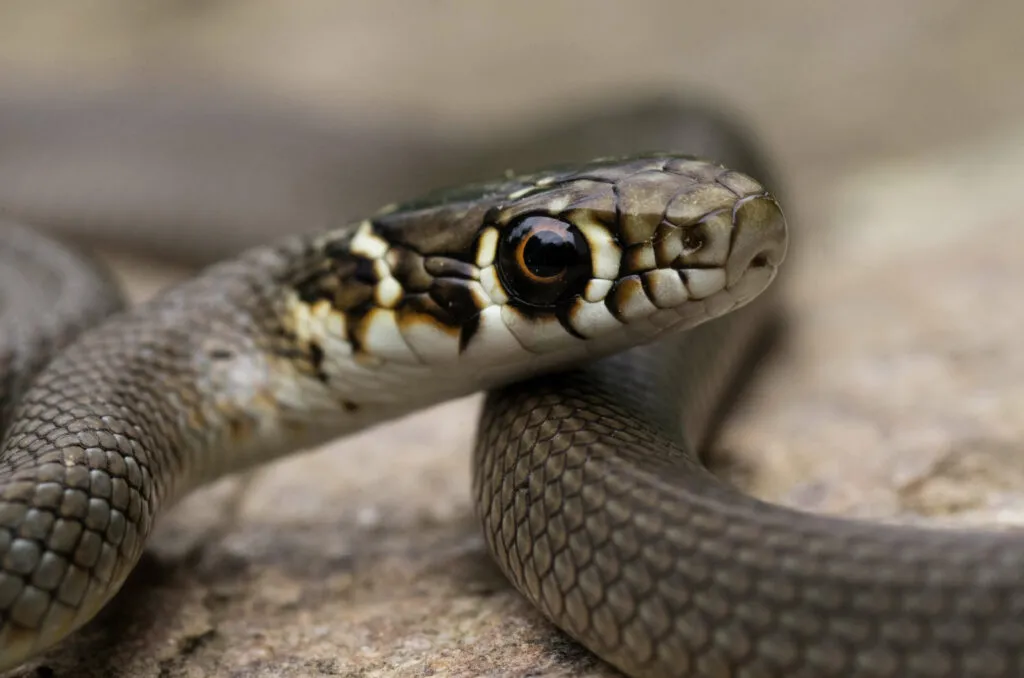
Snake owners know how sensitive their pet’s eyes can be, but only a few are aware of how many things can go wrong when it comes to these organs. The question is how to recognize eye injuries, infections, and congenital disorders your snake may suffer from and what to do to help your exotic pet.
Even though eye problems are not the most common health issues you can see in snakes, you can be surprised by their diversity. It is possible to differentiate infections, physical damages, parasite infestations, or even harmless cloudy eyes that sometimes look suspicious.
This article aims to show you possible eye concerns in snakes. You should know how to help your pet in each situation and keep it healthy and prosperous.
Snake Eye Facts You Should Know First – Reptiles Ophthalmology
Snakes have poor eyesight, have no eyelids, can’t blink, and are forced to sleep with their eyes open. As you can imagine, these facts make them susceptible to various eye problems due to the inability to protect them.
On the other hand, snakes have spectacles, a protective transparent structure attached to the skin that covers their eyes. This membrane is separated from the cornea with a thin fluid layer that keeps the eyes moistened.
Unfortunately, captive snakes are prone to eye issues, typically caused by:
- Retained shed
- Foreign body
- Trauma
- Poor diet
- Inadequate humidity and temperatures in the environment
- Dirty terrarium
Whatever the reason is, you can be sure that your snake has a problem when noticing typical behavior:
- Impossibility to open one or both eyes
- Eye twitching
- Mucus, pus, or a crust in the eye area
- Blurred cornea
- A snake rubs its eyes and face on terrarium sides, accessories, and substrate
Since infections are not the only health issue your exotic pet can face, you should check the list of various possibilities. Be aware that often only a timely reaction and a visit to the vet can save your snake’s eyes or even its life.
Eye Problems in Snakes
As I have already mentioned, eye issues in snakes typically result from improper handling (we show you how often you should handle your snake here) and poor hygiene. However, some problems appear due to inadequate eye drainage or an accident.
Remember that any eye irritation or injury can result in an infection your vet needs to solve with topical antibiotics or injections. Let’s look at a list of snakes’ most common eye issues and how to solve them.
1. Retained spectacles
As you probably know, snakes shed once to four times a year, depending on their age and type. Since their eye spectacles are part of their skin, you can expect to see them removed in that period.
Spectacles are transparent structures over the snake’s eyes that are shed along with the rest of the skin.
Be prepared for your snake’s eyes to become milky-looking before shedding since these reptiles secrete a milky fluid to make shedding quicker and more effortless.
In other words, noticing this change is no need to worry. This process is natural and will repeat every time your exotic pet changes its skin.
Unfortunately, sometimes the process can go wrong, and you can see retained spectacle over one or both of your pet’s eyes. It is possible to recognize a few typical reasons for such a situation, including:
- Inadequate humidity in the terrarium, outside the required 50% to 70% range
- Poor nutrition, dehydration, or suboptimal husbandry
- An inadequate substrate for rubbing or the lack of it
- Improper handling, particularly just before shedding
- Eye or skin infection or sometimes systemic disease
- Low immunity
- Trauma
- Mites infestation or a tick placed along the spectacle edges
In most cases, you can help your pet snake by dripping artificial tears or gently removing the retained shed with a wet cotton swat.
If you can’t do it yourself, it is necessary to visit your vet to prevent possible permanent eye damage.
There is one more thing! Some snake owners believe there is no need to remove retained eye caps because they expect them to come off the next time their pets shed.
This attitude is controversial since the retained spectacle often causes eye damage and vision issues.
2. Blindness

Besides blind snake species, snakes are rarely blind. It may happen after partial shedding when a piece of the shed remains on the eye surface.
If you fail to remove this residue, the condition may lead to blindness and a consequential problem with feeding.
The only way to help your pet is to take it to the vet on time and prevent this condition by timely removing retained spectacles.
3. Cloudy eyes
Milky-looking eyes are a standard condition that appears in snakes just before shedding. However, you should be careful when cloudy eyes appear, although it is not the shed time or the problem remains after the snake finishes this process.
You may face several situations when cloudy eyes are a result of a pathological condition, such as:
- Blocked nasolacrimal duct
- Infection as a complication of blocked nasolacrimal ducts
- Keratitis
- Cataracts
- Fungal infestation
In such a situation, the only option is to treat the underlying disease.

4. Nasolacrimal duct blockage
Snakes have the Harderian lacrimal glands, and their eyes produce tears, but these reptiles can’t cry. The reason is spectacles that are directly attached to the skin, preventing tears from overflowing.
Therefore, any problem with damaged or blocked nasolacrimal ducts results in tears building up in sub spectacular space. It is an area between the cornea and the spectacle for collecting tears before draining through the duct to the oral cavity.
Once an issue with the lacrimal duct blockage and tear accumulation in the sub spectacular space appears, you will notice spectacle bulging (bullous spectaculopathy) in your snake.
Tears are clear initially but become cloudy over time, which is always a warning sign.
Sometimes, this problem disappears spontaneously, but often your vet needs to drain tears after making an incision in the spectacles. The infection may lead to panophthalmitis and surgical eye removal when left untreated.
The most spectacular surgical treatment of this problem happened in 2019. Then, vets decided to create a new nasolacrimal duct for a python suffering from a long-standing eye issue caused by lacrimal duct blockage.
5. Eye trauma
Snakes sometimes hurt their eyes by rubbing their heads over the cage, causing lacerations and abrasions on their surfaces. Sometimes, too aggressive prey can bite the snake targeting its eyes and causing a problem.
In most cases, these incredible reptiles heal injured eyes on their own. Unfortunately, severe infections may sometimes develop, requiring vet intervention and topical antibiotics application.
In these rare cases, when the lacerations are too severe, you need to take your pet to the vet for surgical wound closure. In extreme situations, when the injury is too profound and destroys the globe, it is necessary to remove the entire eye surgically (enucleation).
6. Corneal lesions
This condition is connected with trauma, or a foreign body stuck in the snake’s eye. Your vet will use a black light and topical fluorescein dye to determine cornea damage and treat it with topical medication.
7. Corneal ulceration (keratitis)
This health issue is typical for reptiles in captivity but is not common in snakes because their spectacles protect the cornea.
In rare cases, it appears due to severe trauma, followed by cloudy eyes and ocular discharge.

8. Cataracts
Older snakes may suffer from cataracts when the eyes’ lenses become opaque as a result of:
- Poor nutrition
- Long-term UV rays exposure
- Untreated systemic inflammation resulting in secondary cataract
- Trauma
- Congenital reasons
It is known that tortoises may suffer from cataracts as a result of freezing during hibernation. However, there is no proof that such a thing is possible in snakes.
The first sign of this condition is an eye’s white opacity, so you should react immediately after noticing it. When left untreated, this condition leads to blindness over time.
Nowadays, you can find exotic vets who practice solving this problem by phacoemulsification, a specific cataract surgery method with an excellent prognosis.
9. Glaucoma
Glaucoma is an eye condition that occurs because of damaging the optic nerve that functions as a connection between the eyes and the brain.
The reason is a higher fluid level in the eye’s front part and consequential increasing eye pressure. Luckily, this condition is rare in reptiles, including snakes.
10. Conjunctivitis
Conjunctivitis is a conjunctiva inflammation that appears as an abscess under the snake’s spectacles. The primary causes of this infection include:
- Vitamin A deficiency
- Poor water quality
- Pesticides and chemical agents
- Foreign bodies and trauma
Once the vet diagnoses this condition, the therapy will include topical antibiotics, vitamin A supplementation, and cleaning the affected area. Surgical pus removal is the only successful way to solve the problem with neglected sub spectacular abscesses.
11. Uveitis
Uveitis is a middle eye layer inflammation that rarely occurs in snakes except when diagnosed along with:
- Post hibernation disease
- Systemic infectious disease
- Trauma
- Neoplasia
The only treatment is antibiotics application and surgery in specific cases.
12. Mites and ticks
The fact snakes have no eyelids doesn’t mean they never suffer from tick and mite infestation. In fact, these arachnids may settle in your reptile’s spectacle, causing irritation. Since their removal is pretty challenging, it is recommended to go to the vet and ask for professional help.
13. Fungal infestation
Snake fungal disease is a skin disease found in wild and captive snakes in the eastern US. The fungus Ophidiomyces ophiodiicola typically causes a few symptoms, including opaque or cloudy eyes.
However, fungal infestation is not a typical problem in snakes, especially those kept under controlled conditions. The first case of fungus infestation impacting the eye spectacle in snakes described in detail was in one rainbow boa in 1974.
14. Exophthalmia (exophthalmos)
This medical condition is rare in snakes, particularly those kept in captivity. The vet diagnoses it when a snake has protruding (bulging) one or both eyeballs for some reason, typically after severe trauma or orbital disease.
15. Enophthalmia
There are no scientific studies about this condition in snakes. Once you see sunken eyes in your pet, you can be sure that it suffers from dehydration or weight loss.
It is also a symptom of septicemia and a sure sign that the snake won’t live long.
16. Congenital ocular malformations
Anophthalmia (anophthalmos) is a rare congenital eye defect when a snake is born without one or both eyes. A typical predisposing factor is an improper incubation.
Microphthalmia (microphthalmos) is a rare congenital eye disorder when the snake is born with one or both abnormally small eyes.
Cyclopia is a rare congenital disorder in snakes when two eyes develop in one socket. It is known that such a snake was found in Mississippi in 2018. The exact cause of such deformity is still unknown.
Unfortunately, you can’t do anything when facing a baby snake born with one of these conditions. It usually won’t live long because of accompanying brain deformations.
How to Help?
Eye infections are not so common in snakes and are typically a result of a dirty environment and improper diet. You can prevent most of these health issues with:
- Careful nutrition
- Regular terrarium cleaning
- Maintaining humidity and temperature at the recommended level for each species
Once the eye issue occurs, you must assess the situation well and see whether it is possible to solve the problem on your own.
It is necessary to visit a vet when the case looks severe. They will make a diagnosis and prescribe adequate therapy to reduce the risk of complications.
- Enchi Ball Python: A Unique and Stunning Morph of Python regius - March 27, 2025
- Emerald Tree Monitor: The Enigmatic Green Guardian of the Rainforest - March 26, 2025
- The Egyptian Cobra (Naja haje): A Fascinating Serpent - March 25, 2025
